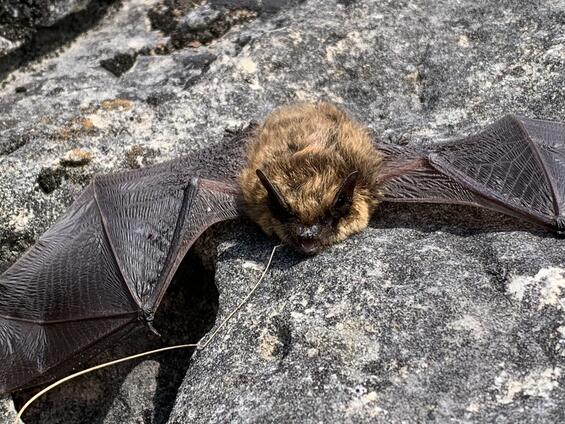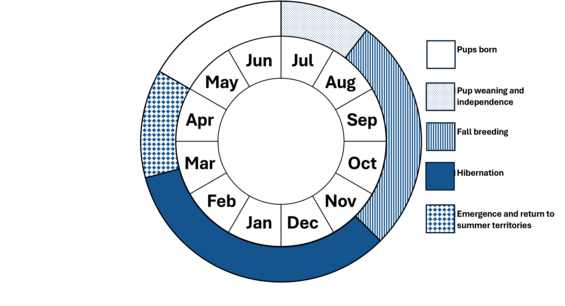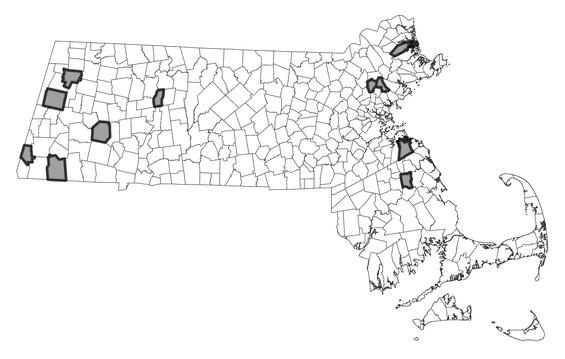- Scientific name: Myotis leibii
- Species of Greatest Conservation Need (MA State Wildlife Action Plan)
- Endangered (MA Endangered Species Act)
Description

Eastern small-footed bat (Myotis leibii)
The eastern small-footed bat (or small-footed myotis) is one of the smallest bats in the eastern U.S., with a forearm length of only 30-36 mm (1.2-1.4 in). The hind foot is tiny (8 mm; <0.3 in.). The total length is about 72-93 mm (2.8-3.7 in). It has golden-tinted, almost yellowish fur and relatively short pinkish forearms. The short ears, tragus, nose and chin are black, as is the face from the nose to the base of the ears and the lower lip, giving a masked appearance. It has a long, pointed tragus and a keeled calcar, distinguishing it from the tricolored bat which has a blunt tragus and no keel. When laid forward, the ears extend slightly beyond the nose.
Similar species: The short forearm measurement will separate an eastern small-footed bat from all other species in Massachusetts except the tricolored bat and some northern long-eared bats. Neither of these species have a keeled calcar, a black mask, or such a tiny hind foot.
Life cycle and behavior
Eastern small-footed bats are hardy and seldom enter their hibernaculum before mid-November and often depart by mid-March. They often roost singly but may be found in small groups. In the summer eastern small-footed bats emerge at dust and fly slowly and erratically gleaning insects in the forest canopy.
Like other Massachusetts cave bats, mating occurs in the fall at hibernation sites, followed by a period of delayed implantation. Active gestation lasts about 60 days, and the single pup is born in late May or June in a female maternity colony.

Population status
The eastern small-footed bat is considered rare in Massachusetts. For over 40 years, the only record of the eastern small-footed bat occurring in Massachusetts was a single specimen found in a Hampden County mine in 1937 and preserved in Harvard University’s Museum of Comparative Zoology. From 1980 to 2017 a few more individuals were documented hibernating in 3 mines and caves, and since 2018, more locations, including several summer records have been documented. The first documentation of breeding did not occur until 2024.
Distribution and abundance
From Ontario and southern Quebec south into the mountains of northern Georgia, and west to Arkansas, Missouri, southern Iowa, and eastern Kansas. In Massachusetts, the small-footed bat may occur nearly statewide, but probably does not occur in the southeastern part of the state or on the islands.

Distribution in Massachusetts
1999-2024
Based on records in the Natural Heritage Database.
Habitat
The eastern small-footed bat is known for occupying rock talus fields and small crevices in rock ledges. They have sometimes been found under rocks on rock outcrops and ledges, and even hibernating in rock piles within mines. Their flattened cranium is believed to be an adaptation for squeezing into tight spaces. In Massachusetts, buildings seem to provide suitable places for shelter in summer. In winter, the species is found in caves and mines.
Threats
The greatest known threat to eastern small-footed bats in Massachusetts comes from white-nose syndrome. Summer habitat availability is not a limiting factor in Massachusetts.
Conservation
The U.S. Fish & Wildlife Service is working in concert with government and non-profit groups to understand the spread of the fungus and potential for stopping its spread. Access to suitable undisturbed hibernacula is essential to the survival of the northern long-eared bat, and protection of known sites is paramount. Human disturbance of hibernacula can be discouraged or prevented with the use of gated entrances, to avoid arousal of hibernating bats and the spread of fungal spores.
All listed species are protected from killing, collecting, possessing, or sale and from activities that would destroy habitat and thus directly or indirectly cause mortality or disrupt critical behaviors. In addition, listed animals are specifically protected from activities that disrupt nesting, breeding, feeding, or migration.
References
MassWildlife. 2020. Homeowner’s Guide to Bats. Massachusetts Department of Fisheries & Wildlife: Westborough, MA. 26 pp.
Whitaker, J.O., Jr. and W.J. Hamilton, Jr. 1998. Mammals of the Eastern United States, Third Edition. Cornell University Press, Ithaca, NY. 583 pp.
Contact
| Date published: | March 4, 2025 |
|---|